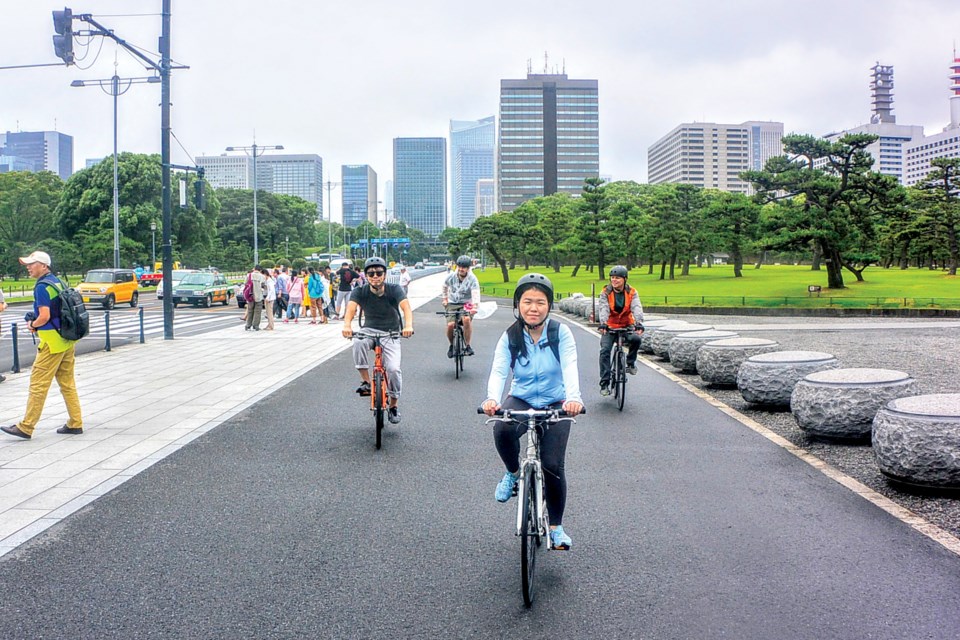Tokyo will be in the sporting spotlight next summer as host of the 2020 Olympic and Paralympic Games. It’s hard to imagine a city better equipped to welcome the world. At 38 million, Tokyo’s residents outnumber all of Canada’s. Their neighbourhoods are connected by a highly efficient, affordable and safe metro, which links to a rail network reaching throughout Japan.
In a little under two weeks this summer, I visited Tokyo, Kobe, Kyoto, Osaka, Nara and Hiroshima. I took an internal flight from Tokyo to Osaka but otherwise rode the Shinkansen Bullet train. If you’re planning to make more than one trip on the Shinkansen, buy the JR Rail Pass before you leave Canada to save money.
The 2003 Indie film, Lost in Translation, perfectly captures the culture shock awaiting travellers newly arrived in Tokyo. The city’s obsessive neon, sci-fi architecture, baffling language and crowds – constant crowds – can be overwhelming, especially with a healthy dose of jet lag. The experience is multiplied in Shinjuku, Tokyo’s entertainment, business and shopping district built around Japan’s busiest train station.
My home for three nights, Shinjuku and nearby Kabukicho, offered a multitude of dizzying distractions. But before I could summon the focus needed to navigate the neighbourhood (and its train station), I wanted to assuage the jet lag by getting my bearings in Tokyo. So, I did what I always do in a new city.
I booked a bicycle tour.
Tokyo is essentially a city of cities. Roppongi, Ginza, Akasaka, Shibuya and Shinjuku will all be familiar to readers of Haruki Murakami’s novels, which is another reason Gakuto (Gaku) Miura’s six-and-a-half-hour cycle tour of Tokyo ancient and modern appealed to me.
Our group of four marvelled at the immense skyscrapers of Shinjuku and Roppongi Hills while also trying to keep our eyes on the busy roads. In contrast, Yoyogi Park offered peaceful riding, as did a stop at the Meiji Jingu Shrine, a Shinto place of worship dedicated to the deified spirits of 19th-century Emperor Meiji and his consort, Empress Shoken.
There were surprises along the way, such as suddenly finding yourself riding through Aoyama Cemetery, final resting place for about 14,000 people and a dog called Hachiko. More than 80 years after his death, Hachiko is still revered for his loyalty after returning to Tokyo’s Shibuya Station every day for nine years, waiting in vain for his master who had died at work.
After cycling through the expensive shopping district of Ginza, the Imperial Palace in Tokyo’s Chiyoda ward had the feel of New York’s Central Park to it: acres of lush green gardens abutting so many square miles of concrete. Inside the park-like setting is the main palace and private residences of Japan’s reclusive Imperial Family.
Back in Hachiko’s day, you could see Mt. Fuji from here. Now you’d need a clear day to ascend the 48-storey Metropolitan Government Building for that view. It’s where Gaku’s tour usually ends. Sadly, the weather gods denied us a glimpse of Japan’s iconic mountain, 100 kilometres away. On the bright side, I think I saw more of Tokyo in a day than Bill Murray did filming Lost in Translation.
Visit bicycletourstokyo.com for more information. If you’re planning a trip to Japan, see ilovejapan.ca/ for a variety of practical travel information.



